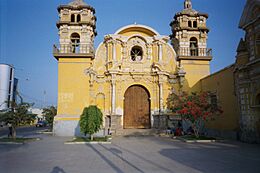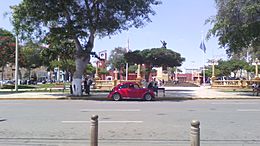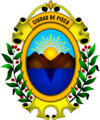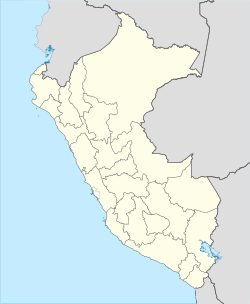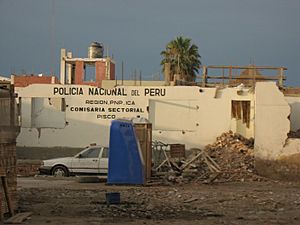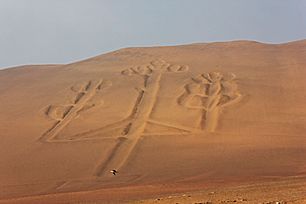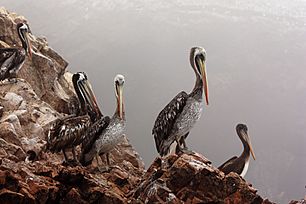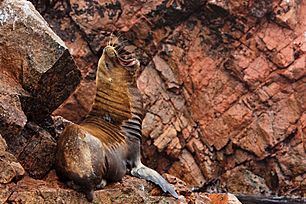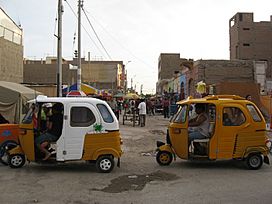Pisco, Peru facts for kids
Quick facts for kids
Pisco
|
|||
|---|---|---|---|
|
City
|
|||
|
|||
| Country | |||
| Region | Ica | ||
| Province | Pisco | ||
| District | Pisco | ||
| Area | |||
| • Total | 3,978.19 km2 (1,535.99 sq mi) | ||
| Elevation | 9 m (30 ft) | ||
| Population | |||
| • Estimate
(2015)
|
104,656 | ||
| Demonym(s) | Pisquena(o) | ||
| Time zone | UTC-5 (PET) | ||
| Website | Official Website: http://www.munipisco.gob.pe | ||
Pisco (Quechua: Pisqu) is a city in the Department of Ica in Peru. It is the capital of the Pisco Province. The city is about 9 meters (28 feet) above sea level. Pisco was founded in 1640. It was built near an old local settlement with the same name. Pisco grew rich because of its vineyards nearby. It became famous for its grape brandy, which was shipped from its port. In 2015, Pisco had an estimated population of 104,656 people.
Contents
History of Pisco
Pisco was a busy city until 1685, when it was attacked by English pirates. In 1687, a big earthquake hit the city. This earthquake also caused a tsunami, which destroyed even more of Pisco.
Even though the land is sandy, many grapevines grow there. This is because of moisture deep in the ground. These vines provided Lima with wines and grape juice. These products were sent to many mountain areas and even as far as Panama and Guayaquil.
After the earthquake and tsunami in 1687, the city was moved to its current spot. It was rebuilt in 1689 and named "Villa de Nuestra Señora de la Concordia de Pisco."
How Pisco Got Its Name
The town of Santa Maria Magdalena was founded in 1572. It had a port called Pisco, named after the valley it was in. This port became very important for sending out a special grape drink. Sailors from all over the world visited the Port of Pisco. This helped the drink become popular internationally.
Over time, the town of Santa Maria Magdalena became known simply as 'Pisco'. The grape drink made there also took the same name. Within a few decades, Pisco (the drink) was sold all along the coasts of Peru and Chile. It was also shipped to other ports in the Pacific and Europe.
Pisco and Peru's Independence
In 1820, a group called the Liberating Expedition of Peru arrived in Pisco. They were led by José de San Martín and Bernardo O'Higgins Riquelme. They landed in the Bay of Paracas. This is where the first flag and the first national symbol of Peru were created.
In 1832, the Peruvian Congress gave the city of Pisco the special title of "Villa y Puerto de la Independencia." This means "Town and Port of Independence." In 1868, Pisco became the capital of the new province of Chincha. In 1898, it was officially made a "city."
The 2007 Earthquake
On August 15, 2007, a very strong earthquake hit south-central Peru. Pisco was very close to the center of this 8.0-magnitude earthquake. News reports said that 80% of the city was destroyed. This included the main San Clemente Cathedral of Pisco, where a church service was happening. About 30% of all the people who died in the earthquake were from Pisco. The city is still recovering from the damage.
Geography and Climate
Pisco's Climate
Pisco has a hot, dry climate, also known as a desert climate. It is warm all year round and gets very little rain. On average, the highest temperature is about 23.7°C (74.7°F). It is warmest in February, around 27.7°C (81.9°F), and coolest in July, around 20.2°C (68.4°F).
The average lowest temperature is about 15.8°C (60.4°F). It ranges from 19.5°C (67.1°F) in February to 12.9°C (55.2°F) in August. Pisco gets very little rain. The total rainfall for a whole year is only about 1.5 mm (0.06 inches).
| Climate data for Pisco (1991–2020, extremes 1942–present) | |||||||||||||
|---|---|---|---|---|---|---|---|---|---|---|---|---|---|
| Month | Jan | Feb | Mar | Apr | May | Jun | Jul | Aug | Sep | Oct | Nov | Dec | Year |
| Record high °C (°F) | 33.9 (93.0) |
33.2 (91.8) |
33.5 (92.3) |
32.0 (89.6) |
30.2 (86.4) |
31.0 (87.8) |
28.0 (82.4) |
28.4 (83.1) |
29.2 (84.6) |
27.0 (80.6) |
28.3 (82.9) |
31.2 (88.2) |
33.9 (93.0) |
| Mean daily maximum °C (°F) | 28.0 (82.4) |
29.3 (84.7) |
28.8 (83.8) |
26.8 (80.2) |
24.0 (75.2) |
22.1 (71.8) |
21.2 (70.2) |
21.1 (70.0) |
21.7 (71.1) |
22.6 (72.7) |
23.9 (75.0) |
25.9 (78.6) |
24.6 (76.3) |
| Daily mean °C (°F) | 23.6 (74.5) |
24.6 (76.3) |
24.2 (75.6) |
22.2 (72.0) |
19.7 (67.5) |
18.1 (64.6) |
17.4 (63.3) |
17.1 (62.8) |
17.6 (63.7) |
18.4 (65.1) |
19.5 (67.1) |
21.6 (70.9) |
20.3 (68.5) |
| Mean daily minimum °C (°F) | 19.3 (66.7) |
20.0 (68.0) |
19.6 (67.3) |
17.6 (63.7) |
15.4 (59.7) |
14.3 (57.7) |
13.7 (56.7) |
13.3 (55.9) |
13.7 (56.7) |
14.4 (57.9) |
15.2 (59.4) |
17.4 (63.3) |
16.1 (61.0) |
| Record low °C (°F) | 10.5 (50.9) |
14.3 (57.7) |
12.0 (53.6) |
10.0 (50.0) |
7.0 (44.6) |
7.8 (46.0) |
7.0 (44.6) |
7.2 (45.0) |
8.0 (46.4) |
7.0 (44.6) |
9.5 (49.1) |
9.2 (48.6) |
7.0 (44.6) |
| Average rainfall mm (inches) | 0.2 (0.01) |
0.1 (0.00) |
0.2 (0.01) |
0.0 (0.0) |
0.0 (0.0) |
0.1 (0.00) |
0.1 (0.00) |
0.3 (0.01) |
0.2 (0.01) |
0.2 (0.01) |
0.1 (0.00) |
0.0 (0.0) |
1.5 (0.06) |
| Average rainy days (≥ 1.0 mm) | 0.1 | 0.1 | 0.0 | 0.0 | 0.0 | 0.0 | 0.1 | 0.0 | 0.1 | 0.2 | 0.0 | 0.0 | 0.5 |
| Average relative humidity (%) | 83 | 81 | 81 | 82 | 83 | 82 | 81 | 83 | 84 | 83 | 82 | 82 | 82 |
| Source 1: Meteo Climat | |||||||||||||
| Source 2: NOAA (rainfall 1961-1990), Deutscher Wetterdienst (precipitation days 1970–1990 and humidity 1954–1969) | |||||||||||||
Travel and Tourism
Pisco Airport
Pisco has an airport called Capitán FAP Renán Elías Olivera Airport. Its airport code is PIO. This airport is used by both regular flights and the Peruvian Air Force. It can also serve as a backup airport for the main airport in Lima, Peru. In 2012, work began to improve the airport. It was expected to handle 400,000 passengers a year by 2017.
Fun Places to Visit
The word Pisco comes from a Quechua word meaning "bird." Many people visit the area to see the amazing marine animals and birds. These can be found at the Paracas National Reserve, often called the Peruvian Galápagos.
Inside the reserve are the Islas Ballestas. These are a group of islands that people cannot visit directly. However, boat tours can get very close. The Chincha Islands are also near the coast. On these islands, you can see many bird species. These include pelicans, penguins, cormorants, Peruvian boobies, and Inca terns. You might also spot sea lions, turtles, dolphins, and even whales.
Another interesting sight is El Candelabro. This is a giant drawing shaped like a lamp, carved into the sandy ground. It was made using the same methods as the famous Nazca Lines.
One of the oldest civilizations in Peru, the Paracas culture, lived in the area where Pisco is now. Because it was easy to reach and connected to the Andes mountains, the Spanish once thought about making Pisco their capital. But they chose Lima instead.
In the city center is the Plaza de Armas. Here, you can buy tejas, which are small sweets made from pecans and different dried fruits. Around the Plaza, you will find a statue of José de San Martín, the house he lived in, and the Municipal Palace. Another important building is the Iglesia de la Compañía. This church was started in 1689. It has a beautifully carved pulpit and a gold-leaf altar.
Close to Pisco, on the road to Ayacucho, is the large and well-preserved Inca site called Tambo Colorado.
Gallery
-
El Candelabro, a large geoglyph often seen on tours to the Ballestas Islands.
Famous People from Pisco
- Raúl Porras Barrenechea, a historian and diplomat.
- Juan de Dios Guevara, a chemist.
- Abraham Valdelomar, a writer.
Sister Cities
Pisco has "sister city" relationships with other cities around the world. This means they share cultural and educational ties.
See also
 In Spanish: Pisco (ciudad) para niños
In Spanish: Pisco (ciudad) para niños







